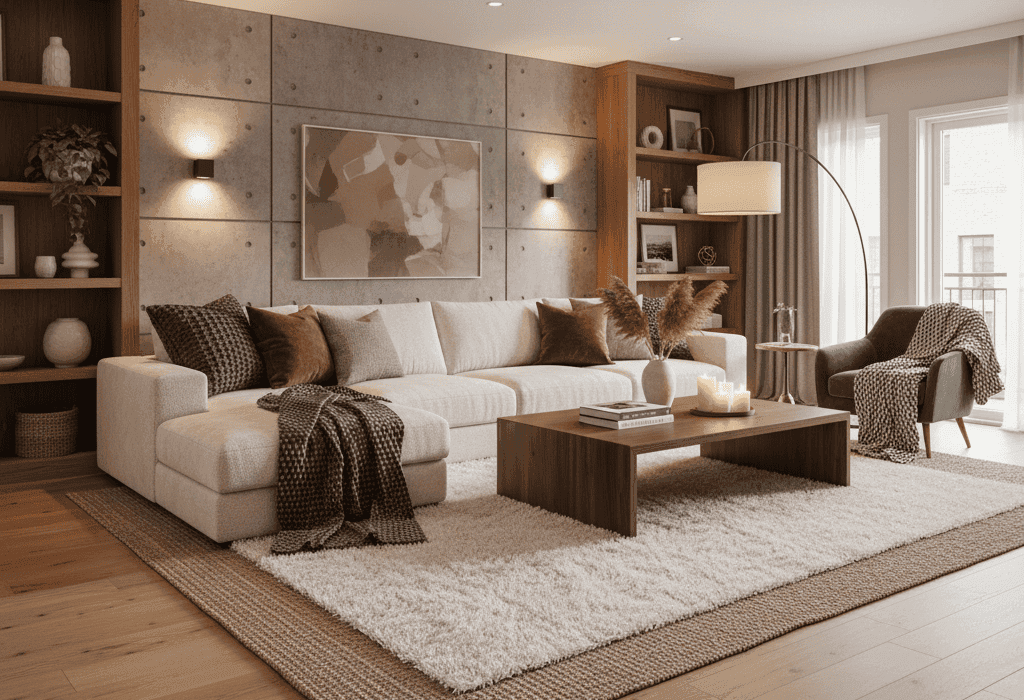12 Strong Ideas for a Cozy Home in 2025
Some homes feel warm before you’ve even crossed the threshold. Others look sharp, expensive, perfectly done—and still somehow cold. In 2025, the quest isn’t only for beauty, it’s for comfort. Not staged comfort, not “catalog” coziness. The sort of lived-in softness that makes you want to stay.
I’ve been digging into design voices and projects, comparing notes across wildly different approaches. It turns out, despite the noise of endless design trends, there’s a backbone forming: a mix of functionality, subtle eccentricity, and a refusal to choose between clean minimalism and daily chaos.
1. Colors with Presence
Forget the obsession with beige everything. Neutral is fine, but neutral can drown you if overdone. Designers are weaving in bold monochromatics—rooms entirely in deep green, moody blues, or layered greys. Even grey on grey can feel new if you play with texture and light.
Quick contrast guide:
| Palette | Effect | Notes |
|---|---|---|
| Grey on grey | Calm, muted | Works with layered textures |
| Bold monochromatics | Dramatic, moody | Needs balanced lighting |
| Pale monochromatic | Airy, soft | Perfect for small rooms |
2. Grand but Grounded
That phrase—grand millennial style—keeps circling back. It’s partly nostalgia, partly rebellion against sterile minimalism. Picture a room with heavy drapery, floral prints, antique lamps, but anchored by sleek furniture. A clash, yet a beautiful one. And yes, a touch of timeless layering makes it work.
You can see similar reflections in interior trends 2020. Even though the year has passed, the ideas still spill into 2025, because design rarely dies—it just mutates.
3. Natural Light as Material
Every architect says it, but few people listen: light is the strongest design tool. A blank slate filled with sun changes everything. In a Los Angeles home, the designer did almost nothing radical—just let the windows breathe. The result wasn’t sterile, it was adaptable, alive.
4. Secrets to Good Interiors
There’s no single rule. Some swear by flow, others by intention. It often comes back to one test: do you want to sit here for more than five minutes? A piece I read on good interior design summed it well—balance, human scale, durability, but also emotion. Without emotional connection, the room is just furniture in a box.
5. Outdoor Living is the New Interior
Strange twist: the best interiors in 2025 sometimes exist outside. Terraces styled like lounges, complete with sculptural elements, texture layering, and modular seating. Outdoor living has evolved—lighting, plant walls, and al fresco comfort merge with traditional “indoor” details.
Checklist for outdoor coziness:
- Layer seating zones
- Use modular furniture
- Build shade structures
- Add accessories for softness
- Keep greenery dense
6. The Office Corner
Everyone has one now, and almost no one gets it right. Working at a dining table kills both work and dining. A better approach: carve out edges, even if small. A rug, a shifted sofa, a bookshelf flipped sideways. The brain relaxes when the space tells it what belongs where.
Practical ideas for organization? Think home office strategies: vertical storage, cable management, minimal clutter. Nothing kills focus faster than wires spilling over your ankles.
7. Curves and Tactile Surfaces
The 2025 look—curved forms, tactile walls, organic shapes. Trendy, yes, but also comforting. Straight lines remind us of machines. Soft bends remind us of bodies. When mixed with bold colors and sustainable materials, a room can feel futuristic without being harsh. You’ll find this direction clearly in interior trends 2025.
8. Functionality over Spectacle
This isn’t about Instagram anymore. Function matters. Daily use matters. A house can be visually perfect but worthless if the chair breaks under you or the layout forces you to walk in circles. And you’d be surprised how often this happens—designs that look flawless in photos but unravel the moment you try to live inside them.
Think about the spaces where you actually spend time. If your kitchen looks stunning but makes cooking a nightmare, you’ll hate it within weeks. If your living room looks like a hotel lobby, guests may admire it, but no one will curl up with a blanket. The real measure of design is whether the space makes your routines smoother, not harder.
Here’s what I scribbled down while looking at modern projects:
- Comfort over form—always test furniture before you buy it.
- Layout logic first—doors, windows, and sightlines need to flow, or you’ll feel boxed in.
- Durable choices always—cheap materials scream after a year.
- Space usage is key—every corner should either rest the eye or serve a purpose.
The spectacular fades fast. Functionality is what you notice every single morning when you shuffle into the kitchen for coffee, every night when you collapse on the sofa.
9. Old + New = Alive
Mixing old and new isn’t just trendy, it’s human. Rooms filled only with brand-new furniture often feel like showrooms, sterile and temporary. But bring in a single antique lamp, or a rug inherited from your grandmother, and the entire mood changes. That imperfect edge, that sense of time layered into the space, suddenly gives it personality.
When everything matches, you stop noticing it. But when there’s friction—modern sofa, vintage chair, contemporary painting, rustic side table—the eye wakes up. The house feels like it has lived multiple lives, not just one. And that’s what makes a space worth returning to.
The trick is balance. Too many old pieces and the room feels dusty, museum-like. Too many new pieces and it feels like a furniture showroom. Aim for the collision, the dialogue, where one era talks to another. That’s when design becomes alive, not static.
10. The Inserted Truth
Some things are hard to ignore. Decorators are talking more about premium home decor trends, where balance between minimalism and functionality becomes the real measure of quality. The phrase sounds lofty, almost overused, but it points to something genuine: our need for homes that feel uncluttered yet not barren, practical yet not soulless.
Minimalism, when done badly, can look like emptiness—cold white walls, furniture so slim it feels uncomfortable, a void that swallows you. Functionality, when pursued without restraint, can look like chaos—clutter piled on clutter, every surface a storage zone. The new focus is not choosing one extreme, but letting them lean against each other until the balance holds.
You might start with a clean palette—white walls, simple lines—but then soften it with tactile fabrics, a vintage rug, or warm wood. Or, flip it: allow a heavily functional space like a kitchen to breathe by clearing surfaces, choosing fewer but better tools, and leaving room for negative space. The “premium” in these trends is not about money, it’s about care. Care in selecting, editing, adjusting until the room feels sharp but also livable.
It’s a truth decorators keep repeating because people keep forgetting: comfort lives in the balance, not in the extremes.
11. Tables, Not Just Desks
Tables are the underrated anchors of domestic life. Desks may define work, beds define sleep, but tables—dining tables, kitchen tables, even oversized coffee tables—hold the heart of a home. They divide zones, create gathering points, and, if chosen boldly, set the tone for everything else.
Think about scale. A big brutal table in an otherwise delicate room doesn’t overwhelm—it stabilizes. It says: this is where things happen. Meals, conversations, projects, arguments, reconciliations. A table carries memory in its scratches and stains, something most “perfect” furniture will never achieve.
Even placement matters. Push a table against the wall, and it loses power. Pull it forward, let it breathe in space, and suddenly the entire room orients itself around it. Lighting above a table acts like punctuation—directing attention, elevating moments.
So when you design, don’t treat tables as afterthoughts. Treat them as landmarks. Without them, homes feel weightless, scattered. With them, homes gain gravity.
12. Beyond 2025
Predictions are exhausting. Every year brings another “top 10 trends” article, and by spring half of them are already irrelevant. But some things last. I think coziness will outlast every fleeting aesthetic, because it’s tied to what people actually crave when the day is done.
Look around—most people are tired. They don’t want a house that feels like a design lab. They want to come home, take off their shoes, and sink into a sofa without worrying about ruining the look. They want rooms where kids can spill juice, where pets can scratch floors, where imperfections don’t break the vibe.
That doesn’t mean giving up on style. It means style that bends, that flexes with life. Coziness isn’t an aesthetic—it’s an atmosphere. It’s the light slanting across a textured rug, the smell of coffee in a kitchen where everything is within reach, the small imperfection that makes a place feel real.
So when 2025 fades into 2026, and the trend reports shift again, the homes that last will be the ones designed not just for the eye but for the body, the mood, the messy rhythm of daily life. That’s the kind of prediction worth keeping.

FAQ
Q1: How can I make a small apartment feel cozy without clutter?
A: Define zones with rugs or furniture shifts, use vertical storage, and mix soft textures with neutral tones.
Q2: Are bold monochromatic rooms practical for everyday living?
A: Yes, if balanced with lighting and varied textures. One color doesn’t mean flat—it can feel rich.
Q3: What’s the most overlooked element in interior design?
A: Light. Not just fixtures but natural daylight, window orientation, and reflective surfaces.
Q4: How do I combine minimalism with personal style?
A: Keep core pieces simple, then layer personal items—art, textiles, heirlooms—for warmth and individuality.
